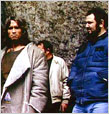
|
|||||||||||||||||||
SOURCES: David Burton. |
|||||||||||||||||||
In the film, Redhair (the Master of the gladiators) releases Conan during a stormy night, one really don't know why. Milius explains in his audio commentary that he cannot keep him any more longer. One guesses in the attitude of the character a mixture of respect and pride (for the formidable fighter that Conan became thanks to him), of debt also (Conan doubtless enabled him to grow richer) and perhaps of fear (if he does not release him now, it is obvious that Conan will have the idea, sooner or later, to flee on his own initiative). If we are to believe David Burton (alt.fantasy.conan, April 1997), Milius shot another version of this scene, in which the release of Conan was much more... providential! |
|||||||||||||||||||
|
|||||||||||||||||||
In fact, the "Conan Files" on the DVD contain a production drawing by William Stout (picture 4) who illustrates this alternate scene. It also appears in the comic book adaptation by Buscema (pictures 1 to 3), as in the novelization (it is discovered there, besides, that Redhair perished at the bottom of the crack which opens under his feet). |
|||||||||||||||||||
|
|||||||||||||||||||
Was this scene really filmed? Oddly, no production still relating to it ever surfaced (at least, not to my knowledge). [see extras updates] Its small "show of force" side goes, moreover, in total opposition to the desire acknowledged by Milius not to transform his hero into the umpteenth substitute of Hercules or Maciste: his Conan indeed does not have anything in common with a strong man from a fun fair who would spend his time twisting iron bars or weight-lifting (this version of Conan is the one developed by the aging Richard Fleischer in his horrible sequel). Just like the Conan who laughs at the demise of his former master and abandons him to his sad fate does not have anything to do with the one portrayed in the film, more innocent, who, as Milius explains it, would almost fear his new freedom, because "freedom is the wolves!". |
|||||||||||||||||||
ConanCompletist 2004






